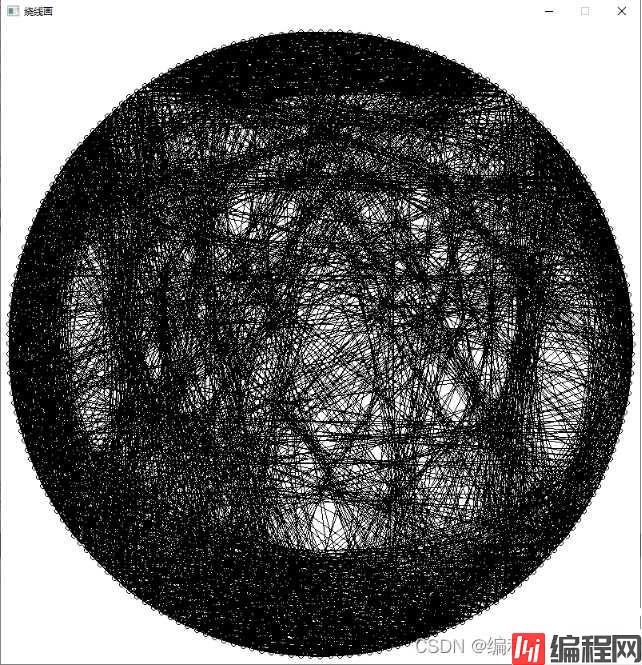目录绕线画简介算法简介示例绕线画简介 简单点来说,就是在木板上钉一圈钉子,通过绕线进行构图,最终呈现出一幅图像。 算法简介 可以总结概括一下, 首先需要有一张图,可以是彩色的,但是必
简单点来说,就是在木板上钉一圈钉子,通过绕线进行构图,最终呈现出一幅图像。
可以总结概括一下,
首先需要有一张图,可以是彩色的,但是必须颜色比较分明。
对图像进行灰度处理。
随机生成 n 组数,就是每两个钉子的组合。
计算 n 组数据连线所过图像像素的平均数,求出最小的一组。
连接该组钉子,并对这条线经过的像素值分别加 m。
重复前面步骤 3 到步骤 5 直到绘制 z 条线结束循环。


#include<graphics.h>
#include<math.h>
#include<coNIO.h>
#include<time.h>
// 以下数据可以自己调节
#define PointNum 288 // 圆圈分的数量(一圈钉子的数量)
#define LineNum 3000 // 循环绘制线的数量
#define RandNum 120 // 设置每次随机生成连接的数量
#define AddColor 52 // 增加的值 0 到 255 值越小越线越集中,越大越分散
#define SIZE 800 // 图像大小
// 以下参数不用调节
#define PI acos(-1.0) // 圆周率
#define R (SIZE / 2 - 10) // 半径
struct PointS
{
int p;
int x;
int y;
};
struct LineS
{
int StarP; // 起点
int EndP; // 终点
};
PointS points[PointNum];
LineS lines[RandNum];
// 为了判断两点是否连线定义的一维数组
bool LineXY[(1 + PointNum) * PointNum / 2] = { false };
bool Line_Rand[(1 + PointNum) * PointNum / 2] = { false };
// 两条线是否连接
bool IsLineKed_Rand(int p1, int p2)
{
if (p1 >= p2)
return Line_Rand[(1 + p1) * p1 / 2 + p2];
else
return Line_Rand[(1 + p2) * p2 / 2 + p1];
}
// 储存已经绘制过的线
void Link_Rand(int p1, int p2)
{
if (p1 >= p2)
Line_Rand[(1 + p1) * p1 / 2 + p2] = true;
else
Line_Rand[(1 + p2) * p2 / 2 + p1] = true;
}
// 将随机生成的进行初始化
void Line2False()
{
for (int i = 0; i < (1 + PointNum) * PointNum / 2; i++)
{
Line_Rand[i] = false;
}
}
// 判断这两个点是否连线
bool IsLinked(int p1, int p2)
{
if (p1 >= p2)
return LineXY[(1 + p1) * p1 / 2 + p2];
else
return LineXY[(1 + p2) * p2 / 2 + p1];
}
// 储存已经绘制过的线
void Link(int p1, int p2)
{
if (p1 >= p2)
LineXY[(1 + p1) * p1 / 2 + p2] = true;
else
LineXY[(1 + p2) * p2 / 2 + p1] = true;
}
int Round(float x); // 取整
void InitPoints(); // 初始化点
void ColorToGray(IMAGE *pimg); // 彩色图像转换为灰度图像
void Random(); // 产生随机数
LineS Getline(IMAGE *pimg); // 获取照片颜色
void ToColor(IMAGE *oriPic, IMAGE *linePic); // 给绕线图赋予颜色
int main()
{
initgraph(SIZE, SIZE);
setbkcolor(WHITE);
cleardevice();
IMAGE imgpolt; // 加载原图
IMAGE oriPic; // 储存原图
IMAGE linePic; // 线图
loadimage(&imgpolt, _T("TG.jpeg"), SIZE, SIZE); // 加载原图
oriPic = imgpolt; // 原图
ColorToGray(&imgpolt); // 将图片转换为灰度
InitPoints(); // 初始化点
srand((unsigned)time(NULL)); // 生成随机种子
for (int i = 0; i < LineNum; i++)
{
Random(); // 随机生成 80
LineS myline = Getline(&imgpolt); // 计算 80 组点中平均值最小的
Link(myline.StarP, myline.EndP); // 记录绘制过的线防止重复绘制
line(points[myline.StarP].x, points[myline.StarP].y, points[myline.EndP].x, points[myline.EndP].y);
}
_getch();
//
// saveimage(_T("test.png")); // 保存一下绕线图
// loadimage(&linePic, _T("test.png"), SIZE, SIZE); // 重新加载绕线图
// ToColor(&oriPic, &linePic); // 用原图将绕线图的颜色替换
// putimage(0, 0, &oriPic);
// _getch();
return 0;
}
// 初始化点(想创新可以生成椭圆的位置坐标)
void InitPoints()
{
for (int i = 0; i < PointNum; i++)
{
double a = i * PI * 2 / PointNum;
points[i].p = i;
points[i].x = int(SIZE / 2.0 + R * cos(a));
points[i].y = int(SIZE / 2.0 - R * sin(a));
setlinecolor(BLACK);
circle(points[i].x, points[i].y, 3);
}
}
// 彩色图像转换为灰度图像
void ColorToGray(IMAGE *pimg)
{
DWord *p = GetImageBuffer(pimg); // 获取显示缓冲区指针
COLORREF c;
for (int i = pimg->getwidth() * pimg->getheight() - 1; i >= 0; i--)
{
c = BGR(p[i]);
c = (GetRValue(c) * 299 + GetGValue(c) * 587 + GetBValue(c) * 114 + 500) / 1000;
p[i] = RGB(c, c, c);
}
}
// 随机生成线
void Random()
{
for (int i = 0; i < RandNum; i++)
{
int starP;
int endP;
while (true)
{
starP = rand() % PointNum;
endP = rand() % PointNum;
if (IsLinked(starP, endP) == false
&& IsLineKed_Rand(starP, endP) == false)
{
break;
}
}
lines[i].StarP = starP;
lines[i].EndP = endP;
Link_Rand(starP, endP); // 记录随机生成的线
}
Line2False(); // 初始化线值
}
// 四舍五入
int Round(float x)
{
return (int)(x < 0 ? x - 0.5 : x + 0.5);
}
// 获取颜色最深的那一条线
LineS Getline(IMAGE *pimg)
{
LineS mylines;
mylines.StarP = 0;
mylines.EndP = 0;
DWORD* p_data = GetImageBuffer(pimg);
int width = pimg->getwidth();
double MaxNum = 255;
int MYsteps;
float X, Y;
float CX, CY;
for (int i = 0; i<RandNum; i++)
{
int SUMDN = 0;
int x1 = points[lines[i].StarP].x;
int y1 = points[lines[i].StarP].y;
int x2 = points[lines[i].EndP].x;
int y2 = points[lines[i].EndP].y;
int steps = abs(x2 - x1) > abs(y2 - y1) ? abs(x2 - x1) : abs(y2 - y1);
float x = (float)x1;
float y = (float)y1;
float cx = (float)(x2 - x1) / steps;
float cy = (float)(y2 - y1) / steps;
for (int j = 0; j < steps; j++)
{
int XIA = width * Round(y) + Round(x);
SUMDN += GetRValue(p_data[XIA]);
x += cx;
y += cy;
}
double Aver = SUMDN / (steps * 1.0);
if (Aver < MaxNum)
{
MaxNum = Aver;
mylines = lines[i];
MYsteps = steps;
X = (float)x1;
Y = (float)y1;
CX = cx;
CY = cy;
}
}
if (MaxNum == 255)
{
return mylines;
}
for (int j = 0; j < MYsteps; j++)
{
int XIA = width* Round(Y) + Round(X);
int c = GetRValue(p_data[XIA]) + AddColor > 255 ? 255 : GetRValue(p_data[XIA]) + AddColor;
p_data[XIA] = RGB(c, c, c);
X += CX;
Y += CY;
}
return mylines;
}
// 给线图上色
void ToColor(IMAGE *oriPic, IMAGE *linePic)
{
DWORD* ori_data = GetImageBuffer(oriPic);
DWORD* line_data = GetImageBuffer(linePic);
for (int i = oriPic->getwidth() * oriPic->getheight() - 1; i >= 0; i--)
{
int oriR = GetRValue(ori_data[i]);
int oriG = GetGValue(ori_data[i]);
int oriB = GetBValue(ori_data[i]);
int lineR = GetRValue(line_data[i]);
int lineG = GetGValue(line_data[i]);
int lineB = GetBValue(line_data[i]);
int newPicR = (int)(255 - (255 - lineR)*(255 - oriR) / 255.0);
int newPicG = (int)(255 - (255 - lineG)*(255 - oriG) / 255.0);
int newPicB = (int)(255 - (255 - lineB)*(255 - oriB) / 255.0);
ori_data[i] = RGB(newPicR, newPicG, newPicB);
}
}到此这篇关于C语言实现绘制绕线画的示例代码的文章就介绍到这了,更多相关C语言绕线画内容请搜索编程网以前的文章或继续浏览下面的相关文章希望大家以后多多支持编程网!
--结束END--
本文标题: C语言实现绘制绕线画的示例代码
本文链接: https://lsjlt.com/news/170820.html(转载时请注明来源链接)
有问题或投稿请发送至: 邮箱/279061341@qq.com QQ/279061341
2024-03-01
2024-03-01
2024-02-29
2024-02-29
2024-02-29
2024-02-29
2024-02-29
2024-02-29
2024-02-29
2024-02-29
回答
回答
回答
回答
回答
回答
回答
回答
回答
回答
0